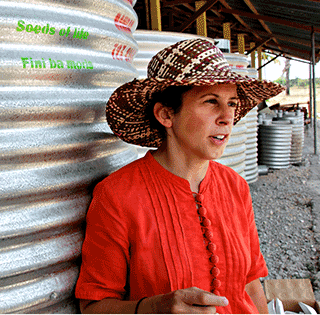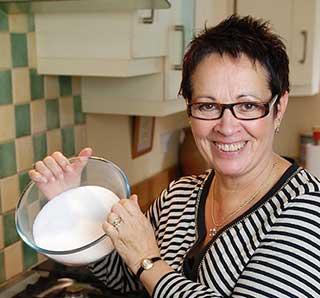 Apologies for the delay in publishing this podcast. One of the joys of not being tied to “proper” radio is the freedom to give a story the length it deserves. The downside is that nobody is cracking the whip to whip things into shape on time, so that sometimes, even with the best will in the world, the schedule slips. Maybe if this were my day job …
Apologies for the delay in publishing this podcast. One of the joys of not being tied to “proper” radio is the freedom to give a story the length it deserves. The downside is that nobody is cracking the whip to whip things into shape on time, so that sometimes, even with the best will in the world, the schedule slips. Maybe if this were my day job …
Bread, yoghurt, pickles: I do love my domestic microbiology. So does Ken Albala, of the University of the Pacific in Stockton, California. His enthusiasm outstrips mine, though, not least because he probably has more space for his experiments. One manifestation of that enthusiasm is a Facebook group dedicated to The Cult of Pre-Pasteurian Preservation and Food Preparation. For Ken, sterilising fermented food is a no-no. Who better, then, to explain how it is that “pickled” has come to mean “boiled in vinegar” rather than “naturally fermented”.
Podcast: Play in new window | Download (Duration: 14:51 — 13.9MB)
Subscribe: Google Podcasts | Spotify | Android | RSS | More
Of course, the whole business of home fermentation has reached fever pitch, manifested by the pickle trend being the number one sketch on a trendy comedy series. Let us not, however, throw the baby out with the brinewater. It really is remarkably easy, and if you want to start, there are endless reams of advice on the internet. Just ignore anything that suggests you boil the proceeds. Emboldened by Ken, I do plan to try sausages some time in the New Year.
Notes
- If you’re on Facebook, do check out Ken Albala’s Cult.
- The current main man on fermentation is Sandor Katz; here’s what he has to say on facultative anaerobes (i.e. Lactobacillus species) versus obligate anaerobes such as Clostridium botulinum, and why you really have nothing to fear.
- Katz also did a great interview with NPR’s Fresh Air.
 One week jam, the next global hunger and malnutrition. That’s the joy of Eat This Podcast; I get to present what interests me, in the hope that it interests you too. It also means I sometimes get to talk to my friends about how they see the big picture around food. Dr Jessica Fanzo, Assistant Professor of Nutrition at Columbia University’s Insitute of Human Nutrition, Special Advisor on Nutrition Policy at the Earth Institute’s Center on Globalization and Sustainable Development, also at Columbia, and much else besides, is one such friend. She was in Rome recently for a preparatory meeting for a big UN conference on nutrition next year, so I took the opportunity to catch up, and to ask some very basic questions about global hunger.
One week jam, the next global hunger and malnutrition. That’s the joy of Eat This Podcast; I get to present what interests me, in the hope that it interests you too. It also means I sometimes get to talk to my friends about how they see the big picture around food. Dr Jessica Fanzo, Assistant Professor of Nutrition at Columbia University’s Insitute of Human Nutrition, Special Advisor on Nutrition Policy at the Earth Institute’s Center on Globalization and Sustainable Development, also at Columbia, and much else besides, is one such friend. She was in Rome recently for a preparatory meeting for a big UN conference on nutrition next year, so I took the opportunity to catch up, and to ask some very basic questions about global hunger.
 When you’re on holiday, or just away from home, do you seek out the “authentic” local food, or look for a reassuringly familar logo? Backpackers, keen to distinguish themselves from the vulgar hordes who are merely on holiday, seek out the authentic, at least to begin with. Dr Emily Falconer has been studying women backpackers. That’s her in the photo, doing a little field research over a bowl of something exotic in Thailand. And she says that while they start out seeking the grottiest places to eat, after they’ve been on the road for a while, their thoughts stray guiltily to familiar, comforting foods. I know the feeling
When you’re on holiday, or just away from home, do you seek out the “authentic” local food, or look for a reassuringly familar logo? Backpackers, keen to distinguish themselves from the vulgar hordes who are merely on holiday, seek out the authentic, at least to begin with. Dr Emily Falconer has been studying women backpackers. That’s her in the photo, doing a little field research over a bowl of something exotic in Thailand. And she says that while they start out seeking the grottiest places to eat, after they’ve been on the road for a while, their thoughts stray guiltily to familiar, comforting foods. I know the feeling Emily Falconer didn’t set out to study backpackers and food, but soon discovered that no matter what the subject, the people she was talking to sooner or later brought up food. I’m no exception, and although I’ve never been a great backpacker myself, I do prefer to seek out reasonably local eating places where I can, and I’ve had some memorable meals as a result. The most memorable of those was in Kunming, China, where I detached myself from the group I was with and went in search of something to eat. I didn’t find it at the food fair that was on at the same time, but in the end I fetched up in a place so authentic it didn’t even have photographs of the food. I indicated to the waiter that I was hungry and he brought me food. I had no idea what any of it was, and aside from one soupy dish that was almost too hot even for me, it was all delicious. Next time I might take with me a book, this
Emily Falconer didn’t set out to study backpackers and food, but soon discovered that no matter what the subject, the people she was talking to sooner or later brought up food. I’m no exception, and although I’ve never been a great backpacker myself, I do prefer to seek out reasonably local eating places where I can, and I’ve had some memorable meals as a result. The most memorable of those was in Kunming, China, where I detached myself from the group I was with and went in search of something to eat. I didn’t find it at the food fair that was on at the same time, but in the end I fetched up in a place so authentic it didn’t even have photographs of the food. I indicated to the waiter that I was hungry and he brought me food. I had no idea what any of it was, and aside from one soupy dish that was almost too hot even for me, it was all delicious. Next time I might take with me a book, this 